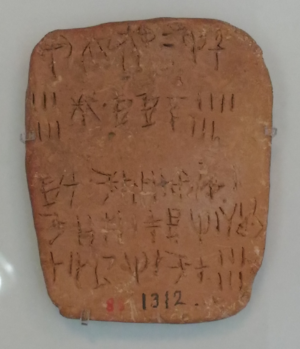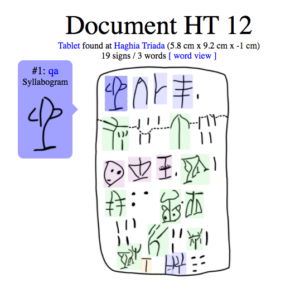 A Minoan clay tablet inscribed with Linear A, on display in Crete’s Archaeological Museum of Heraklion. Dr Ester Salgarella
A Minoan clay tablet inscribed with Linear A, on display in Crete’s Archaeological Museum of Heraklion. Dr Ester Salgarella St. John’s College, University of Cambridge—Huge strides have been made towards deciphering a ‘mysterious’ Greek script that could transform our knowledge of a Bronze Age civilization.
Known as Linear A, the ancient script from Crete appears on some 1,400 inscriptions, most of which are on clay tablets dating back to c1800-1450 BC, during the island’s flourishing Minoan era. A later prehistoric Greek script called Linear B was cracked in the 1950s – but Linear A has continued to elude scholars.
The Minoans were a Bronze Age civilization based on Crete and other islands in the Aegean Sea. Named after the legendary King Minos, this lost civilization was one of Europe’s first urban societies. Ruled from vast palaces, its people were accomplished artists and maritime traders, but their civilization fell into decline after a devastating volcanic eruption on the nearby island of Thera.
Now Dr Ester Salgarella, Junior Research Fellow in Classics at St John’s College, Cambridge, has shed fresh light on the Minoan Linear A script and proved a close genetic link to Linear B, which appeared 50-150 years later in mainland Greece and Crete, c1400-1200 BC. Her research, which has been hailed as ‘an extraordinary piece of detective work,’ could provide the key for linguists to unlock the secrets of the Minoan language – and learn more about its society and culture.
Taking an interdisciplinary approach using evidence from linguistics, inscriptions, archaeology and palaeography (the study of the handwriting of ancient scripts), Dr Salgarella examined the two scripts in socio-historical context. To compare them more easily, she has created an online resource of individual signs and inscriptions called SigLA – The Signs of Linear A: a paleographic database.
She said: “At the moment there is a lot of confusion about Linear A. We don’t really know how many signs are to be taken as core signs, there’s even been a partial misclassification of signs in the past. This database tries to clear up the situation and give scholars a basis for advancement.
“We don’t have a Rosetta Stone to crack the code of Linear A, and more linguistic analysis is required, but this structural analysis is a foundation stone.”
The discovery of the Rosetta Stone, which was inscribed with writing in ancient Egyptian and Greek, helped linguists to understand Egyptian hieroglyphics in the 19th century.
Parallels between signs in Linear A and B have been identified before, but Dr Salgarella has shown that a great many graphic variants of signs in the Minoan script were carried onto Linear B. “This combined palaeographical and structural examination – using sign typology and associations – has led me to revise the current script classification and to argue that these two scripts are actually two sides of the same coin,” said Dr Salgarella. “Most scholars have assumed that because the two languages are different the scripts must be distinct, but the relationship is more subtle than this.”
Following the fall of the Minoan civilization, there is a gap of about 50 years with no archaeological evidence of either script on Crete. Dr Salgarella, who has revealed her findings in her newly published book, Aegean Linear Script(s): Rethinking the Relationship between Linear A and Linear B, said: “There is sufficient evidence that Linear B is a derivative from Linear A, so the question is, how did this transmission process happen? I wanted to find out how we can account for the similarities and, more importantly, the differences, and fill in these gaps.”
The Minoans used Linear A primarily, but not exclusively, for administrative purposes. Small clay ‘labels’ found on Crete bear short Minoan inscriptions on one side and imprints of fibres or string on the other. These suggest the labels were used to secure information written on folded or rolled perishable material, such as papyrus.
Natural disasters caused fires, which destroyed any writing materials and baked the inscriptions into the clay labels and tablets. It’s possible, said Dr Salgarella, that in the two generations between the periods when Linear A ended and Linear B appeared, writing may not have been used widely, but her findings show parts of the earlier script did survive and was adapted by the Greeks into Linear B.
The open access SigLA database of inscriptions has been developed in collaboration with computer scientist Dr Simon Castellan, from the University of Rennes, France. It features a list of 300 standard signs and 400 inscriptions copied by hand. It is still under construction but more than 3,000 individual signs found within the inscriptions are currently searchable.
To form words, the scripts use syllabaries, which means that one written sign or symbol is not a single sound but a syllable. “Other signs are more like Chinese ideograms, or picture words,” said Dr Salgarella. Structural analysis involved looking at how the signs function, the direction they read, and whether they represent syllables, words or punctuation.
Composite signs fall into ‘configurational categories’. “I could see that there is some kind of rationale on how to put them together,” said Dr Salgarella. By examining the patterns, she was able to come to a better understanding of how to read the composite signs, and make sense of some of the combinations.
Dr Salgarella hopes her findings will be a stepping stone to further research by linguists, paleographers and archaeologists working together. She said: “Collecting the Linear A inscriptions in a unified database is of paramount importance to be able to answer sophisticated paleographical and linguistic questions about the Linear A script as well as the Minoan language it encodes, which will help us reconstruct the socio-historical context of the Minoan civilization.”
Professor Tim Whitmarsh, A.G. Leventis Professor of Greek Culture and Fellow of St John’s, said: “Cracking Linear B was a huge post-war triumph for Classics, but Linear A has remained elusive. Dr Salgarella has demonstrated that Linear B is closely related to its mysterious and previously illegible predecessor. She has brought us one step closer to understanding it. It’s an extraordinary piece of detective work.”
_______________________________

A Minoan clay tablet inscribed with Linear A, on display in Crete’s Archaeological Museum of Heraklion. Dr Ester Salgarella
_______________________________

Linear B clay tablet. Dr Ester Salgarella
_______________________________

One of the hand-drawn tablets from the SigLA database featuring different Linear A signs. Dr Ester Salgarella.
_______________________________

Dr Ester Salgarella began studying Linear A and B during her PhD. Her findings are revealed in her book, Aegean Linear Script(s) (Cambridge University Press) Dr Ester Salgarella.
_______________________________
Article Source: St. John’s College, University of Cambridge news release
_______________________________
Advertisement





